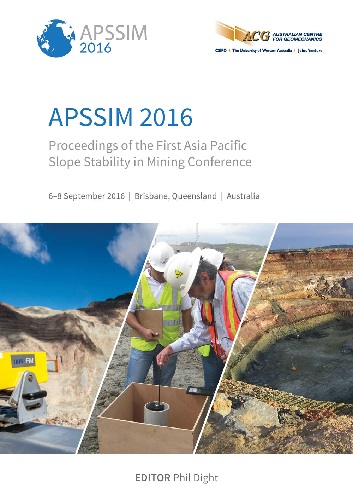Probabilistic slope stability analysis as a tool to optimise a geotechnical site investigation program

|
Authors: Zoorabadi, M; Canbulat, I; Ruest, M |
DOI https://doi.org/10.36487/ACG_rep/1604_31_Zoorabadi
Cite As:
Zoorabadi, M, Canbulat, I & Ruest, M 2016, 'Probabilistic slope stability analysis as a tool to optimise a geotechnical site investigation program', in PM Dight (ed.), APSSIM 2016: Proceedings of the First Asia Pacific Slope Stability in Mining Conference, Australian Centre for Geomechanics, Perth, pp. 485-491, https://doi.org/10.36487/ACG_rep/1604_31_Zoorabadi
Abstract:
Slope stability analysis is a branch of ground engineering science where there are a number of significant uncertainties. Although probabilistic slope stability analysis is an option in most commercial software, the use of this method is not common in practice. Apart from the ability of the probabilistic method to assess the impact of uncertainties on slope stability, it can also be used as a tool to optimise the geotechnical site investigation program. The first-order second-moment approximation of the Taylor series method is one of the probabilistic slope stability methods that determines the relative contribution of uncertainty projected by each component random variable. For a slope with a sequence of different geological units, each unit can be modelled as having several random variables such as cohesion and friction angle. A geological unit whose random variables are responsible for the greatest contribution to the uncertainty in the Factor of Safety (FS) will be the most controlling unit. This characteristic can be used to design geotechnical site investigation programs in order to minimise the uncertainties in these controlling units, which will enhance the Reliability Index of the computed FS. A code developed by the first author will be used in this paper to demonstrate the application of this method in to a real case study.
Keywords: slope stability analysis, probabilistic methods, first-order, second-moment approximation of Taylor series, geotechnical site investigation
References:
Abramson, WL, Lee, TS, Sharma, S & Boyce, G 2002, Slope Stability and Stabilization Methods, 2nd ed., John Wiley & Sons.
Alonso, EE 1976, ‘Risk analysis of slopes and its application to slopes in Canadian sensitive clays’, Geotechnique, 26(3), pp. 453–472.
Ang, AHS & Tang, WH, 1984, ‘Probabilistic concepts in engineering planning and design’, Basic Principles, vol. 2, John Wiley, New York.
Bridle, RC 2000, Dams 2000, British Dam Society, 10th Biennial Conference, Bath, Discussion, 104.
Chowdhury, RN 1978, Slope Analysis, New York: Elsevier Scientific Publishing Company.
Christian, JT 1996, ‘Reliability methods for stability of existing slopes’, in Proceedings of Uncertainty. Geotechnical Special Publication, 2, pp. 409–419.
Christian, JT & Urzua, A 1998, ‘Probabilistic evaluation of earthquake-induced slope failure’, Journal of Geotechnical and Geoenvironmental Engineering, 124(11), pp. 1140–1143.
Dancan, JM, Wright, SG 1980, ‘The accuracy of equilibrium methods of slope stability analysis’, in Proceedings of the International Symposium on Landslides, New Delhi, vol. 1, pp. 247–254.
Eddleston, M, Beeuwsaert, L, Taylor, J & Gardiner, KD 2004, ‘Development of a probabilistic methodology for slope stability and seismic assessments of UK embankment dams’, Long-term benefits and performance of dams, Thomas Telford.
El-Ramly, H 2001, ‘Probabilistic analysis of landslide hazards and risk: Bridging theory and Practice’, PhD thesis, University of Alberta, Canada.
El-Ramly, H, Morgenstern, NR & Cruden, D 2002, ‘Probabilistic Slope Stability Analysis for Practice’, Canadian Geotechnical Journal, 39, pp. 665–683.
Fenton, GA & Griffiths, DV 2008, Risk Assessment in Geotechnical Engineering, John Wiley and Sons, New York.
Griffiths, DV & Fenton, GA 2004, ‘Probabilistic slope stability by finite elements’, Journal of Geotechnical and Geoenvironmental Engineering, 130(5), pp. 507–518.
Hahn, GJ & Shapiro, SS 1967, Statistical Models in Engineering, John Wiley & Sons, Inc., pp. 230–232.
Hassan, AM & Wolff, TF 1999, ‘Search algorithm for minimum reliability index of earth slopes’, Journal of Geotechnical and Geoenvironmental Engineering, ASCE, 125(4), pp. 301–308.
Li, DQL, Zhang, D, Cao, ZJ, Tang, ZS & Phoon, KK 2015, ‘Response surface methods for slope reliability analysis: Review and comparison’, Engineering Geology, .
Malkawi, AIH, Hassan, WF & Abdulla, FA 2000, ‘Uncertainty and reliability analysis applied to slope stability’, Structural Safety, 22(2), pp. 161–187.
Rettemeier, K, Falkenhagen, B & Köngeter, J 2000, ‘Risk assessment – New trends in Germany’, Transactions of the 20th International Congress on Large Dams, Bejing, pp. 625–641.
Santa Marina, J, Altschaeffi, A & Chameau, J 1992, Reliability of slopes incorporating quantitative information, Transport Research Record 1343, pp. 1–5.
Smith, GN 1986, A suggested method of reliability analysis for earth retaining structures, TRRL Report No. 46.
Suchomel, R & Mašin, D 2010, ‘Comparison of different probabilistic methods for predicting stability of a slope in spatially variable soil’, Computer and Geotechnics, 37(1-2), pp. 132–140.
US Army Corps of Engineers 1997, Introduction to probability and reliability methods for use in geotechnical engineering, Engineering Technical Letter No. 1110-2-547.
Wolff, TF 1985, ‘Analysis and design of embankment dam slopes: a probabilistic approach’, PhD thesis, Purdue University, West Lafayette.
Zoorabadi, M 2004, ‘Probabilistic stability analysis of rock slopes’, Masters thesis, Tarbiat Modares University, Iran.
© Copyright 2025, Australian Centre for Geomechanics (ACG), The University of Western Australia. All rights reserved.
View copyright/legal information
Please direct any queries or error reports to repository-acg@uwa.edu.au
View copyright/legal information
Please direct any queries or error reports to repository-acg@uwa.edu.au